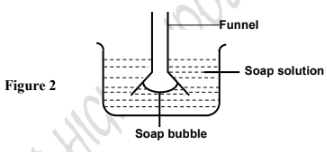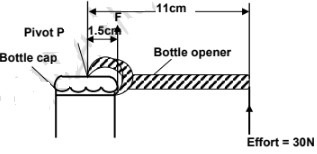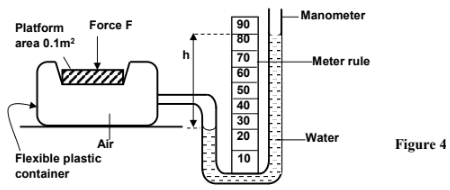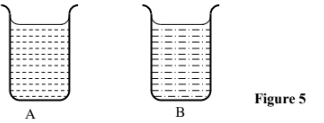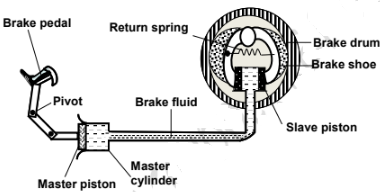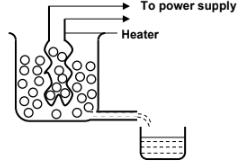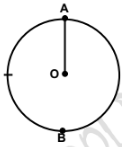Instructions to candidates
- This paper consist of TWO sections; A and B. Answer ALL the questions in section A and B in the spaces provided.
- ALL working MUST be clearly shown. Mathematical tables, electronic calculators and slide rules may be used.
Take: density of water = 1gcm−3 ,g = 10N/kg
SECTION A: 25 MARKS
- The micrometer screw gauge shown in figure 1 was found to have an error of + 0.04 mm
Figure 1- Define the term zero error (1 mark)
- Give the correct reading of the micrometer (1 mark)
-
- What is surface tension? (1 mark)
- Figure 2 shows a funnel dipped into a liquid soap solution.
Explain what happens to the soap bubble when the funnel is removed. (2 marks)
- A boy on a bicycle accelerated uniformly at 1m/s2 for 10 seconds from an initial velocity of 4m/s. Calculate the distance travelled in this time. (3 marks)
- An object is attached to a spring balance and its weight determined in air. It is then gently lowered into a beaker containing water.
- State what happens to the reading. (1 mark)
- Explain the force that causes observation in (a) above. (1 mark)
- A metal cube weighs 1.0N in air and 0.8N when totally immersed in water. Calculate:
- Volume of water it displaces. (2 marks)
- the density of the cube (2 marks)
- State how the velocity of a moving fluid varies with pressure. (1 mark)
- Figure 3 shows a bottle opener.
Figure 3
A force of 30N is applied at a distance of 11cm from the pivot P. A force F acts at the edge at a distance 1.5cm from P. Calculate the force F on the edge of the cap. (2 marks) - Figure 4 shows a manometer used to measure the pressure difference between the air inside a plastic container and the atmosphere outside.
Calculate the force F exerted on the container. (3 marks) - A student observes that in the morning an overhead electrical cable is straight and taut. At midday the student observes that the same cable has sagged. Explain these observations.
(2 marks) - A rubber tube is inflated to pressure of 2.7 x 105 pa and volume 3800cm3 at temperature of 250C. It is then taken to another place where the temperature is 150C and the pressure is 2.5 x 105 pa. Determine the new volume (3 marks)
-
- Figure 5 shows two containers filled with two different liquids to the same height.
It was found that the pressure at the bottom of A is greater than that at B. Explain (1 mark) - Figure 6 shows a car braking system. The brake fluid is an oily liquid.
Figure 6
The brake drum rotates with the wheel of the car.- Explain how pushing the brake pedal makes the brake rub against the drum. (4 marks)
- The cross-sectional area of the master piston is 2.0 cm2. A force of 140N is applied to the master piston.
- Calculate the pressure created in the brake fluid by the master piston. (2 marks)
- The cross-sectional area of each slave piston is 2.8 cm2. Calculate the force exerted on each slave piston by the brake fluid. (2 marks)
- The force exerted on the master piston is greater than the force applied by the foot on the brake pedal. Using the principle of moments, explain this (2 marks)
- Figure 7 shows a master cylinder sealed at one end. Instead of brake fluid, the cylinder contains air.

Figure 7
When a force is applied to the piston, the length d changes from 6.0 cm to 4.0 cm. The pressure of the air increases but the temperature stays constant.- Describe how the molecules of air exert a pressure. (1 mark)
- Explain why the pressure increases even though the temperature stays constant.
(1 mark) - The initial pressure of the air inside the cylinder is 1.0 x 105 pa. Calculate the final pressure of the air. (2 marks)
- Figure 5 shows two containers filled with two different liquids to the same height.
-
- What is a machine? (1 mark)
- Two gear wheel have an 80 teeth (driven) and 20 teeth (driving) and lock with each other. They are fastened on axles of equal diameters such that a weight of 150N attached to a string round one axle will just raise 450N on the other axle.
Calculate:- M.A (2 marks)
- V.R (2 marks)
- Efficiency of the machine. (2 marks)
- The graph in figure 8 shows the variation of force with distance for a body being towed. Figure 8
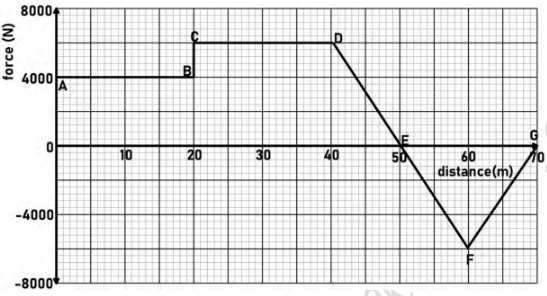
Figure 8
Calculate the total work done on the body. (3 marks)
-
- Distinguish between distance and displacement. (2 marks)
- A jet fighter moving horizontally at a speed of 200m/s at a height of 2 km above the ground is to drop a bomb to hit a target on the ground. How long does the bomb stay in air after release before it hit the target? (3 marks)
- Two equal masses travel towards each other on a frictionless air track at speeds of 60cm/s and 40cm /s as shown in figure 9.
Figure 9
If they stick together on impact, what is the velocity of the masses after impact? (2 marks) - Figure 10 shows a simple pendulum oscillating between Y and Z.
Figure 10
State the type of energy the body possesses at:- Position Y (1 mark)
- Position X (1 mark)
-
- Define the term latent heat of fusion. (1 mark)
- In an experiment to determine the power of an electric heater, melting ice was placed in a container with an outlet and the heater placed in the ice as shown in figure 11. The melted ice was collected.
Figure 11- Other than the current and voltage, state the measurement that would be taken to determine the quantity of heat absorbed by the melted ice in unit time. (1 mark)
- If the latent heat of fusion of ice is Lf, show how measurement in (i) above would be used in determining the power P of the heater. (2 marks)
- It is found that the power determined in this experiment is lower than the manufacturer’s value indicated on the heater. Explain. (1 mark)
- A mass of wax of 1kg was heated uniformly by a 100W heating element until it melted. The graph in figure 12 shows how the temperature of the wax varies with time.
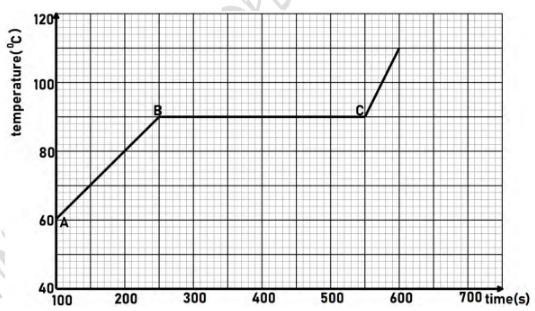
Figure 12- Explain what is happening in the region AB (2 marks)
- Calculate the specific heat capacity of the wax. (2 marks)
- Calculate the specific latent heat of fusion of wax. (3 marks)
-
- A stone of mass 450g is rotated in a vertical circle at 3 revolutions per second as shown in figure 13.
If the string has a length of 1.5m, determine:- the linear velocity (3 marks)
- The tension of the string at positions A and B. (4 marks)
- State two factors affecting centripetal force. (2 marks)
- A stone of mass 450g is rotated in a vertical circle at 3 revolutions per second as shown in figure 13.
MARKING SCHEME
-
- A type of error in which an instrument mgives a reading when the true reading at the time is zero ✓1
- 6.06mm − 0.04 = 6.02mm ✓1
-
- A force that makes the surface of a liquid to behave like a fully stretched elastic skin ✓1
- the soap bubble recedes until it flattens to a film at the nneck of the funnel. In so doing, it tries to make its ,surface as small as possible because of surface tension. ✓1
- S = ut + ½at2 ✓1
= (4 ×10) + (½ × 1 × 102) ✓1
= 90m ✓1 -
-
It reduces ✓1 - Due to upthrust force - upward force acting on an object immersed in a fluid, hence its apparent weight is less than the real weight. ✓1
-
-
- u = vpg
1.0 − 0.8 = v × 1000 × 10 ✓1
v = 2.0 × 10-5 m3 ✓1 - p = m/v = 0.1kg ✓1
2.0 × 10-5m3
= 5000kg/m3 ✓1
- u = vpg
- Inversely proportional // If pressure increases, velocity decreases. if pressure decreases velocity increases. ✓1
- Sum of clockwise moments = Sum of anticlockwise moments
1.5/100 × F = 11/100 × 30 ✓1
F = 220N✓1 - F = P × A = hpg × A ✓1
= (80 − 20) × 1000 × 0.1 × 10 ✓1
100
= 600N ✓1 - In the morning, they are straight and taught because of the cold hence it contracted. ✓1 At midday, the cables expand due to the heat from ,the sun, hence sag.✓1
- P₁V₁ = P₂V₂ ✓1
T₁ T₂
2.7 × 10⁵ × 3800 = 2.5 × 10⁵ × V₂ ✓1
298 288
V₂ = 3966.28cm3 ✓1 -
- A is denser than B ✓1
-
-
- When the pedal is pushed, pressure is generated in the master cylinder. ✓1
- This pressure is transmitted to the slave cylinder. ✓1
- This causes the pistons of the slave cylinder to open the brake shoe. ✓1
- Hence the brake lining presses the drum [to cause braking action] ✓1
-
P = F/A = 140 ✓1
2 × 10−4m2
= 7000000N/m2//700000Pa ✓1 - F = P × A
= 700000 × 2.8 × 10−4 ✓1
= 196N ✓1 - Distance from the foot to pivot is larger than distance from piston to the pivot ✓1.
Since the product of force and distance remains constant ✓1
-
-
-
- Molecules hit against the walls/ piston✓1
- Molecules hit more frequently due to smaller volume ✓1
- P1V1 = P2V2
1 × 10−5 × 6cm = P2 × 4cm ✓1
P2 = 1.5 × 105 Pa ✓1
-
- It is an apparatus used to make work easier. ✓1
-
- = Load = 450N ✓1
Effort 150N
= 3 ✓1 - = No. of teeth in driven wheel = 80/20 ✓1
No, of teeth in driving wheel
= 4 ✓1 -
n = M.A × 100%
V.R
= ¾ × 100% ✓1
= 75% ✓1
- = Load = 450N ✓1
- Work done = Area under curve ✓1
= (4000 × 20) + (6000 × 20) + (0.5 × 20 × −6000) ✓1
= 170000J ✓1
-
- Distance is the complete length of the path between two points✓1, while displacement is the direct length between any two points when measured along the minimum path between them ✓1 (w.t.t.e)
- S = ut + ½gt2 (for vertical motion, u = 0) ✓1
2000 = 0 + ½ × 10 × t2 ✓1
t = 20s ✓1 - m1u1 + m2u2 = (m1 + m2)Vc
(m × 60) + (m × −40) = m + m)Vc ✓1
Vc = 10cm/s ✓1 -
- Potential energy ✓1
- Kinetic energy ✓1
-
- Quantity of heat required to change state of a given mass from solid to liquid or liquid to solid without change in temperature. ✓1
-
-
- mass of melted ice, m
- time taken to melt the ice, t ✓1
- Heat given out by heater = Heat absorbed by melting ice
Pt = Vit = mLf
P = mLf ✓1
t - Not all ,the heat supplied by the heater is used to melt the ice, some are lost to the surrounding hence lower value ✓1
-
-
- As heat is supplied to the max, the temperature of the wax increases from 60°C ✓1
to 90°C. The heat supplied is used to raise the temperature of wax. ✓1 - m.c.Δθ = p.t
1 × c × (90−60) = 100 × (250 − 100) ✓1
c = 500 J/kgK ✓1 - m. Lf = P.t ✓1
1 × Lf = 100 × (550 − 250) ✓1
Lf = 30000 J/Kg ✓1
- As heat is supplied to the max, the temperature of the wax increases from 60°C ✓1
-
-
- ω = 2πf
= 2 × 22/7 × 3
= 18.86 rad/s ✓1
v = rω = 2πf × r
= 1.5 × 18.86 ✓1
= 28.29m/s ✓1 - At A: T = mv2 − mg
= 450 (28.292 − 10) ✓1
1000 1.5
= 235.6N ✓1
At B: T = mv2 + mg
r
= 450 (28.292 + 10) ✓1
1000 1.5
= 244.6N
- ω = 2πf
-
- mass of the object ✓1
- linear velocity of the object ✓1
- radius of the circle ✓1
-
Join our whatsapp group for latest updates
Tap Here to Download for 50/-
Get on WhatsApp for 50/-
Download Physics Paper 1 Questions and Answers - Maranda High Pre Mock Exams 2023.
Tap Here to Download for 50/-
Get on WhatsApp for 50/-
Why download?
- ✔ To read offline at any time.
- ✔ To Print at your convenience
- ✔ Share Easily with Friends / Students


